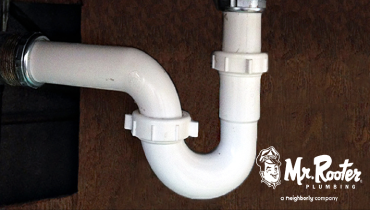
If you’ve ever dropped a precious item down a sink or had to deal with an unwelcome drain clog, you need to know about P-traps. These handy pieces of under-sink plumbing serve a variety of purposes to help keep your home sanitary and your plumbing running smoothly.
We’ll explain what a P-trap is, how to tell if yours is working, and answer some questions about these important pipes.
- What Exactly is a P-Trap?
- What Does a P-Trap Do?
- How to Tell If Your P-Trap is Working Correctly
- P-trap FAQs
What Exactly is a P-Trap?
A P-trap is a U-shaped piece of pipe underneath your sink. It’s designed for easy removal and cleaning to help prevent clogs. Many P-traps have a cap on the bottom, known as a cleanout. The cleanout can be unscrewed by hand if you need to remove a clog from the trap.
What Does a P-Trap Do?
P-traps serve a few important purposes as part of your plumbing system. They do the following:
- Trap debris and prevent clogs. Clogs often form in P-traps. However, that high likelihood of clog formation serves a purpose. The U-shaped bend of a P-trap sometimes traps small pieces of debris, preventing clogs further down in your pipes. Fortunately, most P-traps have a cleanout that makes clog-clearing easy.
- Protect against property losses. Though not intended for this particular purpose, P-traps can also bail you out in a jewelry jam. If wedding rings, necklaces, or other small, prized possessions slip into the sink drain, the P-trap may catch these valuables before they’re lost forever. You can retrieve them using the cleanout.
- Stop sewer gases from infiltrating your home. The primary purpose of P-traps is to prevent sewer gases from getting into your home. This is important since prolonged exposure to sewer gases can lead to illness and other health issues. Sewer gas is also flammable, so you want to do everything possible to keep it out. The P-trap’s U-bend holds a pool of water, forming an airtight seal that the sewer gases cannot pass.
How to Tell If Your P-Trap is Working Correctly
P-traps seem straightforward, and they generally are. But things can still go wrong if they are misused. Common issues with P-traps include:
- P-trap overload: A single P-trap cannot handle wastewater from more than two or three water-based appliances.
- No tap primer on infrequently used fixtures: When P-traps are rarely used, the water inside dries up over time, preventing them from forming an airtight seal that keeps out sewer gases. If you have fixtures you don’t use often, a P-trap primer can keep them filled. These primers inject water into the P-trap whenever its water level starts to dip.
- Insufficient ventilation: Improperly vented drains, such as those in older homes and cabins, will empty slowly. This can cause a “glugging” noise in your P-trap. It is caused by air bubbles forcing their way through the liquid inside your P-trap. Over time, this can dry out the P-trap and allow sewer gases into your home.
P-trap FAQs
How do I clear a clogged P-trap?
Clearing a clogged P-trap is easier than it may seem. While most clogs require special tools like drain snakes, a clogged P-trap can be cleared without much plumbing equipment. This is thanks to the cleanout found at the bottom of many P-traps.
If your P-trap is clogged and has a cleanout, start by laying a towel and bucket underneath the cleanout. Once those items are in place, open the cleanout by unscrewing the cap at the bottom of the P-trap. After opening the cleanout, use gloves to remove any items stuck in the pipe.
Some P-traps don’t have a cleanout; in this case, you’ll need to try a few different methods. The first and most effective method is to remove the P-trap. Lay a towel and bucket down beneath the P-trap. Use a wrench to loosen the connections on the pipe until the P-trap comes free. Then, you can brush out the inside of it before putting it back in place.
Alternatively, if you don’t want to remove any pipe, you can use a sink plunger. This handy device forces water into your pipes at a high pressure, dislodging debris.
If all else fails, it’s best to call a professional. They can diagnose the issue and clear the clog quickly so your P-trap can perform effectively.
Fix a Broken P-Trap with Help from Mr. Rooter Plumbing
Now that you know what a P-trap is, you can determine if yours is working properly or if it needs some maintenance. If you’re dealing with sink drain and P-trap issues, look to the experts at Mr. Rooter Plumbing for a fast resolution. Keep things flowing in the right direction. Contact us today.

